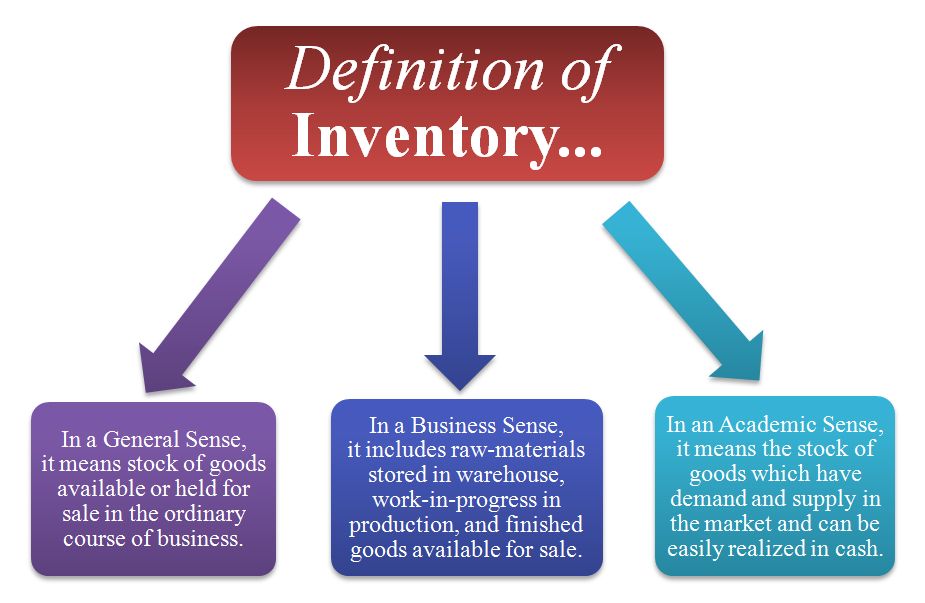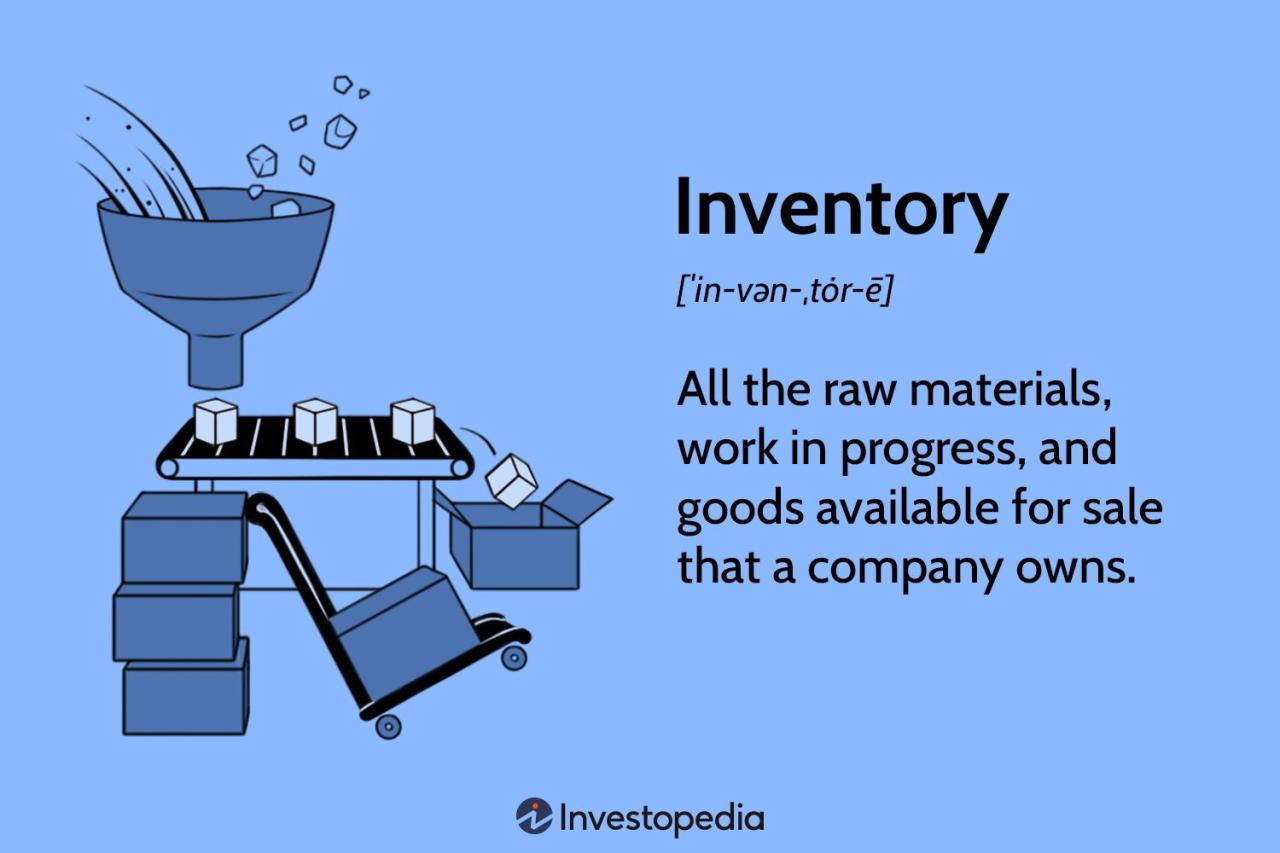Business inventory terms are the building blocks of effective inventory management. Understanding these terms is crucial for businesses of all sizes to optimize their stock levels, reduce costs, and improve customer satisfaction.
This guide will delve into the essential concepts of business inventory terms, covering everything from valuation methods to forecasting techniques. By gaining a solid grasp of these terms, businesses can empower themselves to make informed decisions about their inventory management strategies.
Inventory Valuation Methods

Inventory valuation methods are accounting techniques used to determine the value of inventory on a company’s financial statements. The method chosen can significantly impact the company’s financial performance and tax liability.
Specific Identification Method
This method assigns a specific cost to each unit of inventory. It is most accurate but also the most time-consuming and complex method. It is often used for high-value or unique items.
First-In, First-Out (FIFO) Method, Business inventory terms
This method assumes that the first units purchased are the first units sold. The cost of goods sold is based on the cost of the oldest inventory on hand. This method results in a higher cost of goods sold and lower ending inventory in inflationary periods.
Last-In, First-Out (LIFO) Method
This method assumes that the last units purchased are the first units sold. The cost of goods sold is based on the cost of the newest inventory on hand. This method results in a lower cost of goods sold and higher ending inventory in inflationary periods.
Weighted Average Cost Method
This method assigns an average cost to all units of inventory. The average cost is calculated by dividing the total cost of inventory by the total number of units. This method is relatively simple to use and provides a more stable cost of goods sold than FIFO or LIFO.
Advantages and Disadvantages of Each Method
The choice of inventory valuation method depends on several factors, including the nature of the inventory, the company’s accounting policies, and the tax implications. The specific identification method is the most accurate but also the most complex. FIFO and LIFO can result in significant distortions in financial statements during periods of inflation or deflation.
The weighted average cost method is a compromise between accuracy and simplicity.
Inventory Control Systems

Inventory control systems are designed to manage the flow of inventory through a business. They help businesses track inventory levels, identify trends, and make informed decisions about ordering and stocking. There are a variety of inventory control systems available, each with its own strengths and weaknesses.
Types of Inventory Control Systems
- Periodic Inventory System:This system is based on the assumption that inventory levels are constant throughout the period. The inventory is counted at the end of the period, and the cost of goods sold is calculated based on the beginning inventory, purchases, and ending inventory.
- Perpetual Inventory System:This system tracks inventory levels on a continuous basis. Every time an item is purchased or sold, the inventory is updated. This system provides more accurate information about inventory levels, but it is also more complex and time-consuming to maintain.
Comparison of Inventory Control Systems
| Feature | Periodic Inventory System | Perpetual Inventory System |
|---|---|---|
| Accuracy | Less accurate | More accurate |
| Complexity | Less complex | More complex |
| Timeliness | Less timely | More timely |
| Cost | Less expensive | More expensive |
Steps Involved in Implementing an Inventory Control System
- Define the scope of the system.This includes identifying the types of inventory that will be tracked, the level of detail that is required, and the desired accuracy of the system.
- Select the appropriate software.There are a variety of inventory control software packages available, each with its own strengths and weaknesses. It is important to select a software package that is compatible with the business’s needs and budget.
- Implement the system.This involves training staff on how to use the software, setting up the system, and entering inventory data.
- Monitor the system.Once the system is implemented, it is important to monitor it on a regular basis to ensure that it is working properly and that inventory levels are accurate.
Inventory Optimization: Business Inventory Terms
Inventory optimization is the process of determining the optimal level of inventory to hold, with the goal of minimizing total inventory costs while meeting customer demand.
There are several strategies for optimizing inventory levels, including:
- Just-in-time (JIT) inventory: This strategy involves holding only enough inventory to meet current demand, reducing the risk of obsolescence and spoilage.
- Safety stock: This is a buffer of inventory held to protect against unexpected increases in demand or disruptions in the supply chain.
- Economic order quantity (EOQ): This is the optimal quantity of inventory to order at a time, based on factors such as demand, holding costs, and ordering costs.
Technology plays a vital role in inventory optimization, providing tools for tracking inventory levels, forecasting demand, and automating ordering processes. By leveraging technology, businesses can improve the accuracy and efficiency of their inventory management, leading to reduced costs and improved customer service.
Closing Notes

In conclusion, business inventory terms provide a comprehensive framework for understanding the complexities of inventory management. By mastering these terms, businesses can unlock the potential for improved efficiency, cost savings, and enhanced customer service. Embracing the concepts Artikeld in this guide will empower businesses to navigate the challenges of inventory management with confidence and achieve operational excellence.
FAQ Insights
What is inventory valuation?
Inventory valuation is the process of determining the value of a company’s inventory for accounting purposes.
What are the different inventory valuation methods?
The three main inventory valuation methods are FIFO (first-in, first-out), LIFO (last-in, first-out), and weighted average cost.
What is inventory management?
Inventory management is the process of planning, organizing, and controlling the flow of inventory within a business.
What are the benefits of inventory management?
Inventory management can help businesses reduce costs, improve customer satisfaction, and increase efficiency.